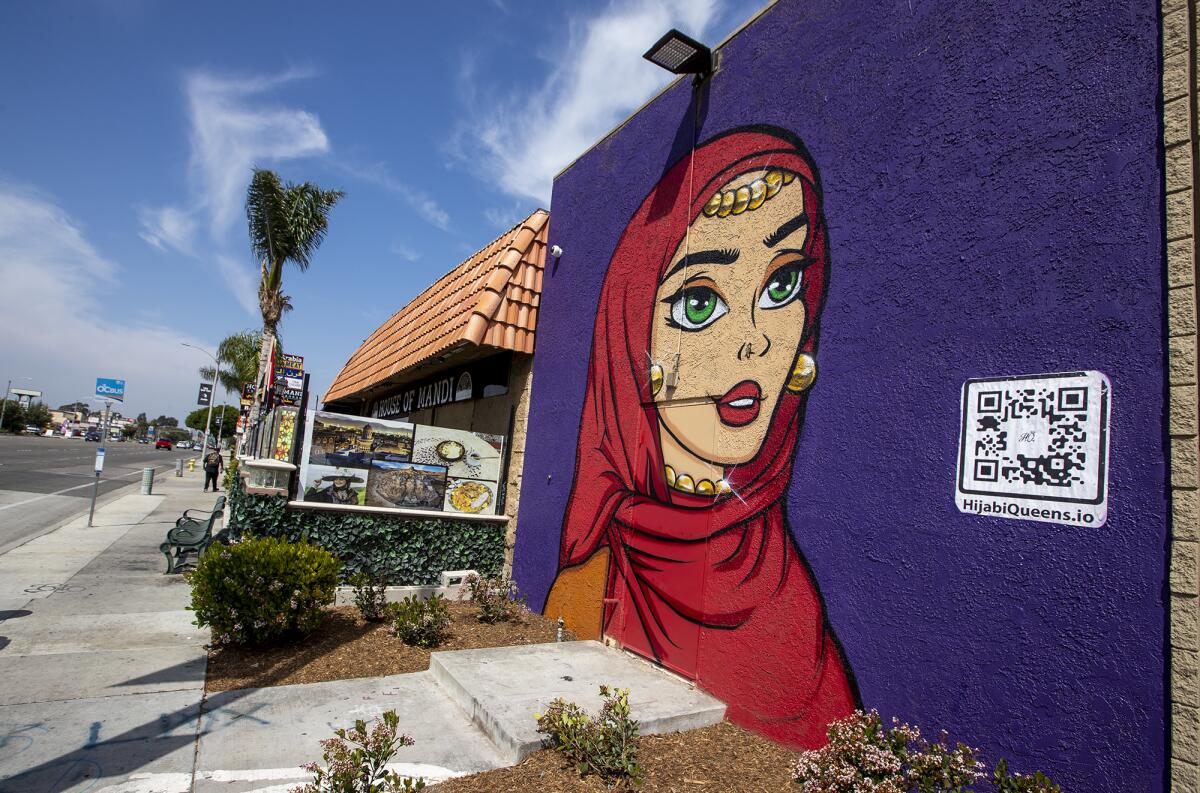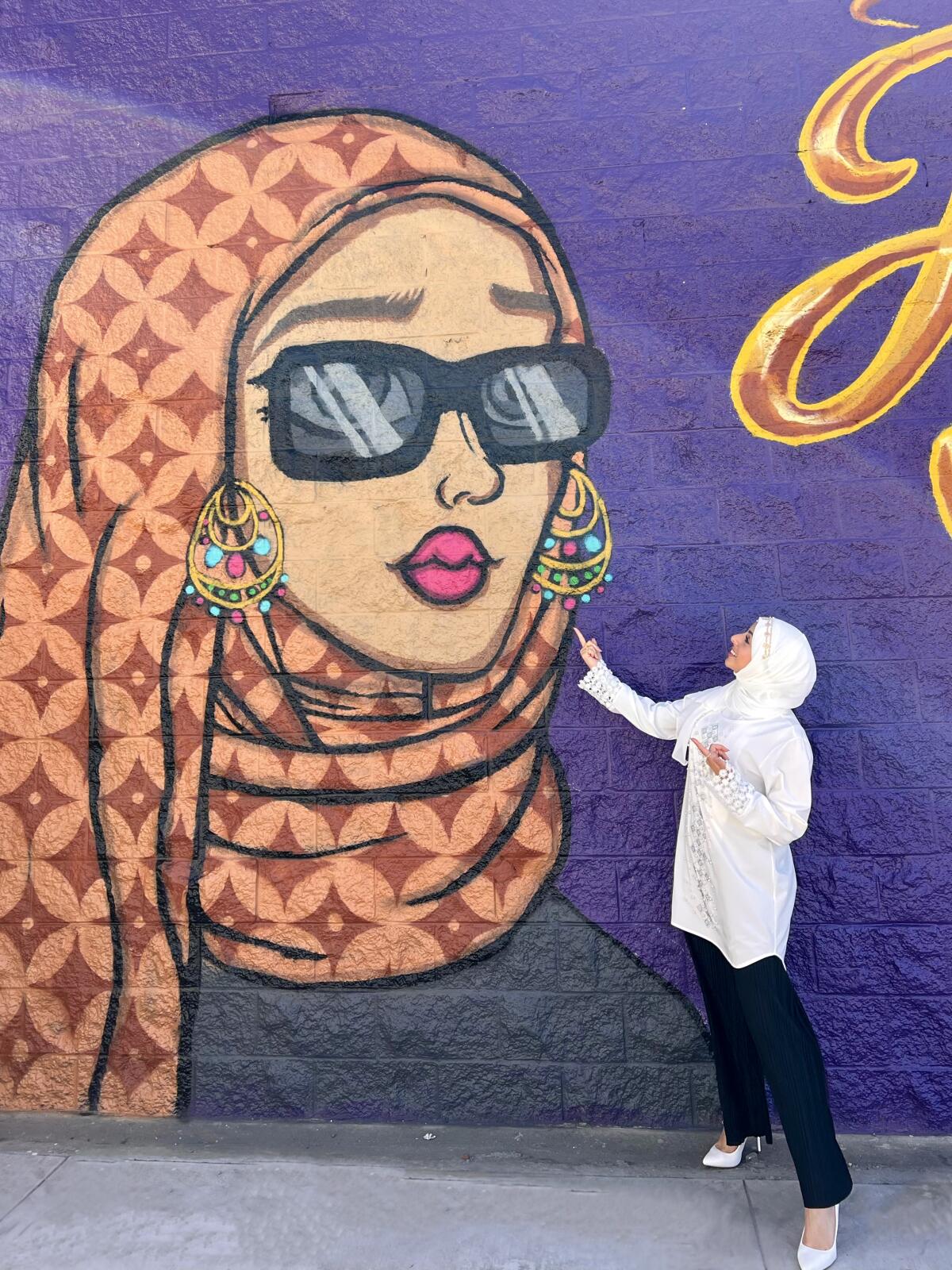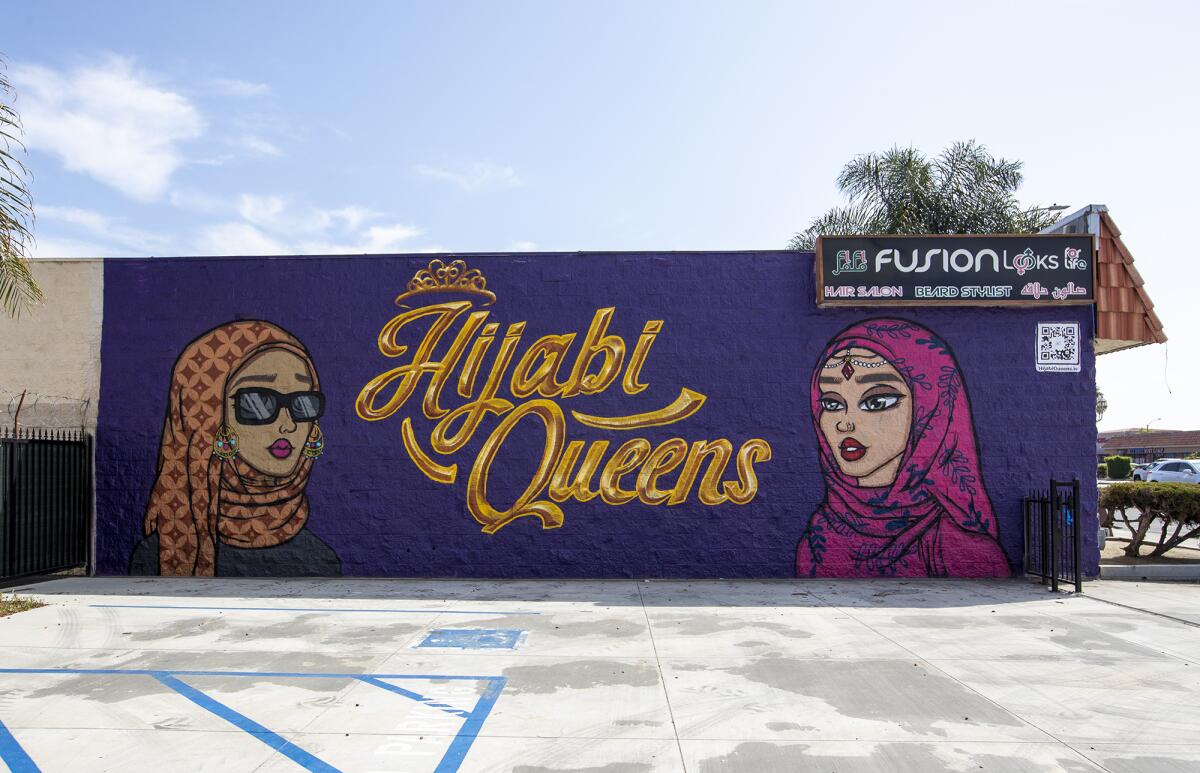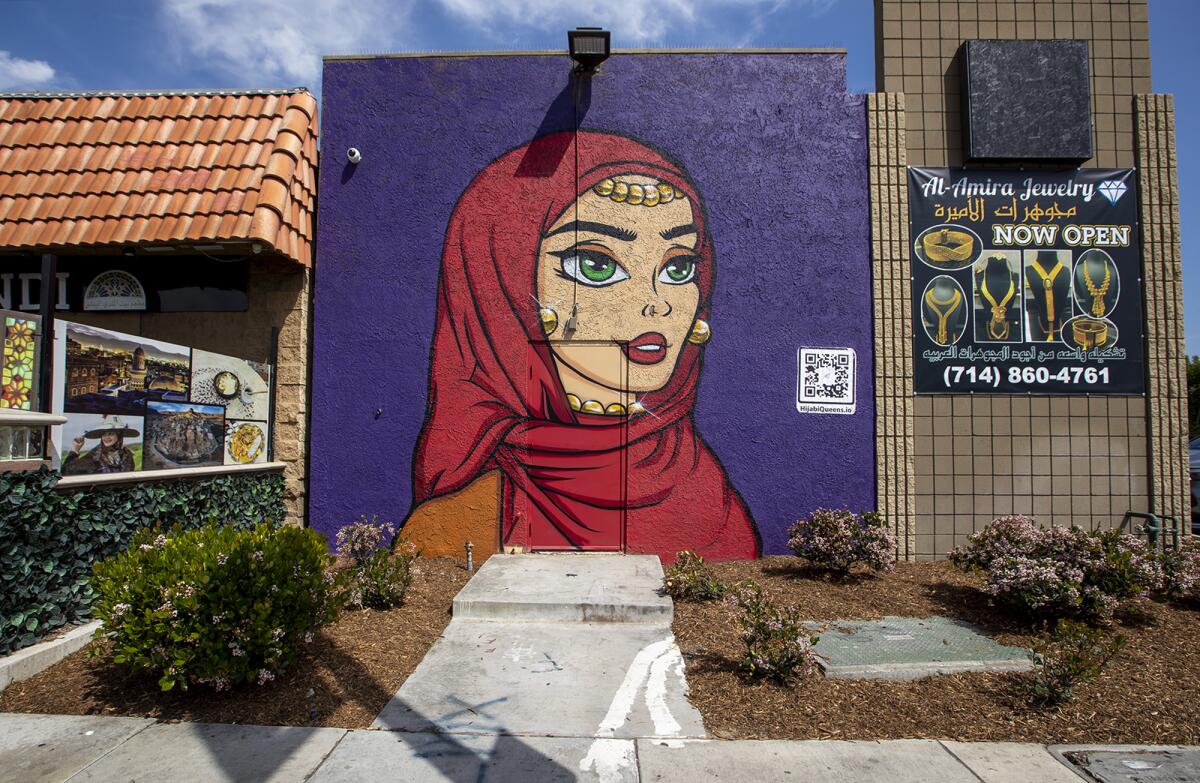‘Hijabi Queens’ give Anaheim’s Little Arabia a bold, new look

- Share via
Fatmah Muhammad drove down Brookhurst Street in Anaheim on her way to drop off knafeh, a cheesy Palestinian pastry, at local restaurants and Altayebat Market when she suddenly pulled over.
Kareemah Williams, her daughter, caught sight of a colorful “Hijabi Queens” mural beaming from the Little Arabia district’s thoroughfare.
“Mama, please pull over,” Williams said. “We’ve got to take a picture!”
Muhammad, the Muslim businesswoman behind Knafeh Queens, put her deliveries on hold at her daughter’s insistence.
“Her excitement, it was priceless,” Muhammad said.
Mother and daughter took turns posing in front of the mural for photos before Muhammad uploaded them to her Instagram business page.
It’s the start of a new trend.
The newest artistic addition to the ethnic enclave is quickly becoming an Instagram hotspot, especially for hijabis, or Muslim women who wear headscarves in religious observance.
Karter and Doaa Zaher, the husband-wife team behind “Hijabi Queens,” have already been tagged in an overwhelming number of selfies and photos with the mural only finished last week.

“The community is thirsty for this type of representation,” said Doaa, a hijabi herself who also works as an emergency room nurse. “We’ve been misrepresented for far too long. This feels like we’re taking the mic back and showing the world how beautiful and vibrant hijabi women are.”
It’s all part of a larger vision.
Karter, a Lebanese rapper, songwriter and author, recorded “Hijabi Queens,” an uplifting song, nearly a decade ago. Together with his wife, he later co-wrote “My Magical Hijab,” a children’s book.
Based in Los Angeles, the married couple have now co-founded “Hijabi Queens” as an ambitious NFT project.
“The best way I can explain it is that we’re trying to create a halal network in Web3,” said Karter, using a tech term for a newer version of the internet based on blockchain technology. “We’re taking initiative to be the first project to bring the Muslim community into the Metaverse.”
As a starting point, the Zahers promoted the release of “Hijabi Queens,” a collection of 5,000 unique art pieces fashioned much like the mural that can be individually owned but not duplicated. They will be followed by an equal number of “Bearded Kings” NFTs.
“Part of our vision was if we reached a certain amount of NFTs,” Karter said, “we were going to allocate those funds towards painting some walls.”
The search began in Los Angeles, but several locations just didn’t fit.
A friend suggested a look at Anaheim and its Little Arabia district in particular. The strip’s restaurants and other businesses held majestic murals rich in Middle Eastern history within their walls, but nothing ever public, outside and front-facing.
One meeting led to another and soon Karter presented his mural vision to Ahmad Alam, the longtime property owner of Brookhurst Plaza, a hub of Arab American small businesses.
“We want to give representation to Muslim women,” Karter explained. “We want to empower them.”
Alam walked him around the plaza and asked which walls he wanted.
Karter pointed to a blank slab of concrete in between House of Mandi, a Yemeni restaurant, and Al-Amira Jewelry, a newly opened business adjacent to Brookhurst Plaza. Alam agreed. Next, he asked about another one behind Maestro’s Barbershop and received another approving nod.

Alam felt the mural project would benefit the community and be an outpost of positive representation.
“It’s good work and fits the Little Arabia project,” Alam said. “That’s what convinced me to do it. It’s as simple as that.”
By the meeting’s end, Karter secured three blank concrete canvasses, in total, to bring the “Hijabi Queens” vision to fruition.
Kodjovi Sevon, a Los Angeles artist known as Jayo-V, began painting the murals based on Colombian artist Andrés Restrepo’s original work. The “Hijabi Queens” aesthetic is personified in the Muslim women’s large, expressive eyes, colorful hijabs and a stylish swagger.
Al-Amira Jewelry’s owner also suggested that the artwork by his business accessorize accordingly.
“It worked out,” Karter said. “The mural actually looks a lot nicer with the jewelry added.”

The finished product stands as a bold artistic statement along Brookhurst Street, which, according to the city, sees about 35,000 commuters per day.
And people are taking notice.
“I rarely, if ever, saw myself in media and art,” said Enjy El-Kadi, a hijabi and digital communications manager for the L.A. chapter of the Council on American-Islamic Relations, whose office is along Brookhurst Street. “With the ‘Hijabi Queens’ murals, it is nice to see women who wear hijab portrayed in public art in a way that is positive, empowering, and an accurate reflection of our diverse community. It allows us to feel seen.”
Along the barbershop’s back wall, a larger mural depicts two “Hijabi Queens” at opposite ends. A third, smaller mural of a younger hijabi sporting a tiara is tucked between Brookhurst Plaza businesses.
All feature a QR code that links back to the “Hijabi Queens” NFT project website.
Beyond being a selfie spot for hijabis to feel celebrated, Doaa hopes that the murals stand as an invitation to education and a means by which to break stereotypes about Muslim women.
“I was always the only hijabi in all of my college classes and workspaces,” she said. “Literally, I was the first Muslim that a lot of people ever had a close encounter with.”
Doaa faced uninformed questions from them, like if Muslim women were allowed to wear a hijab in any other color besides black.
The mural provides a colorful response.
“We’re challenging what is normal and we’re increasing representation so that when young kids are growing up in these cities, they have a wide array of diversity,” she said. “We’re not doing anything more than just representing ourselves the way we actually are.”
All the latest on Orange County from Orange County.
Get our free TimesOC newsletter.
You may occasionally receive promotional content from the Daily Pilot.




